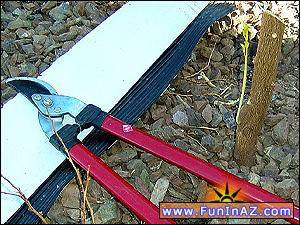Notice the white line indicating the meyers lemon cutting, and lower you can see a blue line indicating the root stock portion. This sucker is growing above the grafting line, the angled cut line just below the new growth, which means it is still the meyers lemon tree and will not grow into whatever the rootstock is; I can't think of the rootstock it would have been grown on? I'll find out and edit this later.
Here is where I cut the tree trunk. I cut it just above the meyer sucker growth as to not damage it accidentally with the loppers. I'm planning on leaving alone to grow and see what happens while I save enough money to buy a new citrus tree.
I'm planning on leaving alone to grow and see what happens while I save enough money to buy a new citrus tree.
 I'm planning on leaving alone to grow and see what happens while I save enough money to buy a new citrus tree.
I'm planning on leaving alone to grow and see what happens while I save enough money to buy a new citrus tree.Information I found regarding the Meyer lemon:'Meyer'–a hybrid, possibly lemon X mandarin orange; introduced into the United States as S.P.I. #23028, by the agricultural explorer, Frank N. Meyer, who found it growing as an ornamental pot-plant near Peking, China, in 1908; obovate, elliptical or oblong, round at the base, occasionally faintly necked and furrowed or lobed; apex rounded or with short nipple; of medium size, 2 1/4 to 3 in (5.7-7.5 cm) wide and 2 1/2 to 3 1/2 in (6.25-9 cm) high; peel light-orange with numerous small oil glands, 1/8 to 1/4 in (3-6 mm) thick; pulp pale orange-yellow, usually in 10 segments with tender walls, melting, juicy, moderately acid with medium lemon flavor; seeds small, 8 to 12. Tends to be ever bearing but fruits mostly from December to April. Tree small, with few thorns, prolific, cold-resistant; produces few water sprouts, and is only moderately subject to greasy spot and oil spotting. It is easily and commonly grown from cuttings. Does well on sweet orange and rough lemon rootstocks; is not grafted onto sour orange because it is a carrier of a virulent strain of tristeza. Grown for home use in California; in Florida, both for home use and to some extent commercially for concentrate though the product must be enhanced by the addition of peel oil from true lemons, since that from 'Meyer' peel is deficient in flavoring properties. Has been fairly extensively planted in Texas and in Queensland, Australia, and New Zealand.

No comments:
Post a Comment